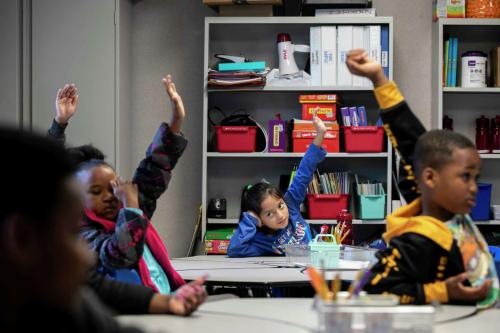This piece was first published by Next City.
On Wednesday, September 6, while high school students across Boston enjoyed the final day of their summer break, dozens of volunteers fanned out across the city. Their mission: Visit the homes of students who were chronically absent last year or who left high school before graduating, and try to get them to restart their education.
Door-knocking is an annual initiative of the Boston Public Schools Re-Engagement Center (REC), a trailblazing program that helped reduce the high school dropout rate in its city by more than half. Thanks to strong leadership from Boston’s Mayor Michelle Wu and Superintendent Mary Skipper, and the cross-sector collaboration that led to the creation of the Boston REC, high school graduation rates in Boston are up and more young people are on track to successful and fulfilling lives.
An analysis from the Brookings Institution and Child Trends emphasizes how important high school reengagement programs like Boston REC are. When researchers looked at the factors shaping young adults’ employment pathways, they identified the lack of a high school diploma as one of the strongest predictors that a young person will struggle to find economic stability throughout their 20s.
To assess the potential for upward economic mobility, the researchers narrowed their analysis to teens who grew up in households earning below 200% of the federal poverty line—about $60,000 for a family of four in 2023 dollars—or whose parents did not have college degrees.
They found that almost 60% were struggling economically at age 30 with low wages and high poverty rates. More than half (52%) of the lowest-earners left high school without a diploma, as did about one-third of the second-lowest earning group. While some of those without diplomas went on to earn a GED, having a GED was not associated with higher earnings. Graduating from high school was.
Dropping out of high school has countless downstream effects, not just for students but for entire communities. Leaders in Boston understood the stakes when the city became one of the first to launch an effort to re-engage dropouts back in 2006. Established as a partnership between Boston Public Schools and the Boston Private Industry Council, the city’s workforce development board, the REC set out to bring students back to school while they were still entitled to a free public education. The REC doesn’t just reach out to students to try to get them to re-engage; it also offers a variety of services and supports designed to support students to re-enroll and stay in school.
Over the past decade, the Boston REC has helped nearly 5,000 students who left high school before graduating by listening to their stories, assessing their educational options, and helping them select a path to a diploma, often through an alternative education program.
It’s part of the reason why the Boston Public Schools system graduates substantially more students today; the four-year graduation rate went from 59% in 2006 to 81% in 2022. The five-year rate jumped from 65% to 84%. Even with this progress, though, nearly one in five first-time ninth-graders in Boston do not graduate within four years.
Boston’s experience mirrors national trends: High school graduation rates have increased, but they are far from a level we should be satisfied with, considering that the consequences of not earning a diploma are so severe. That’s why the field of high school reengagement is ripe for further investment and expansion.
The National League of Cities recognized this when they formed the Reengagement Network to support peer learning and field-building. Subsequently, the U.S. Department of Education has also recognized the importance of reengagement centers, and researchers are documenting different program models and evaluating a notable Washington state policy supporting re-engagement efforts to further develop the evidence base.
With ample proof-of-concept and a solid body of knowledge to tap into, high school reengagement offers cities and towns across the country a way to give more young people the basic foundation they need for lasting economic stability—with substantial collateral benefits for the community, taxpayers, the workforce, and society as a whole.





Commentary
Op-edBoston’s High School Dropout Rate Fell By More Than Half. Here’s Their Blueprint
October 12, 2023